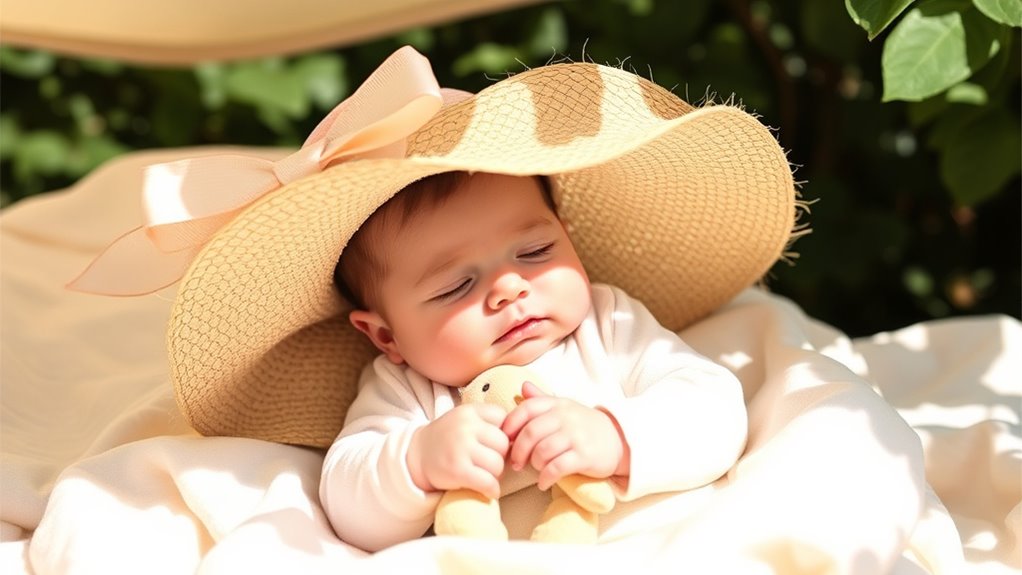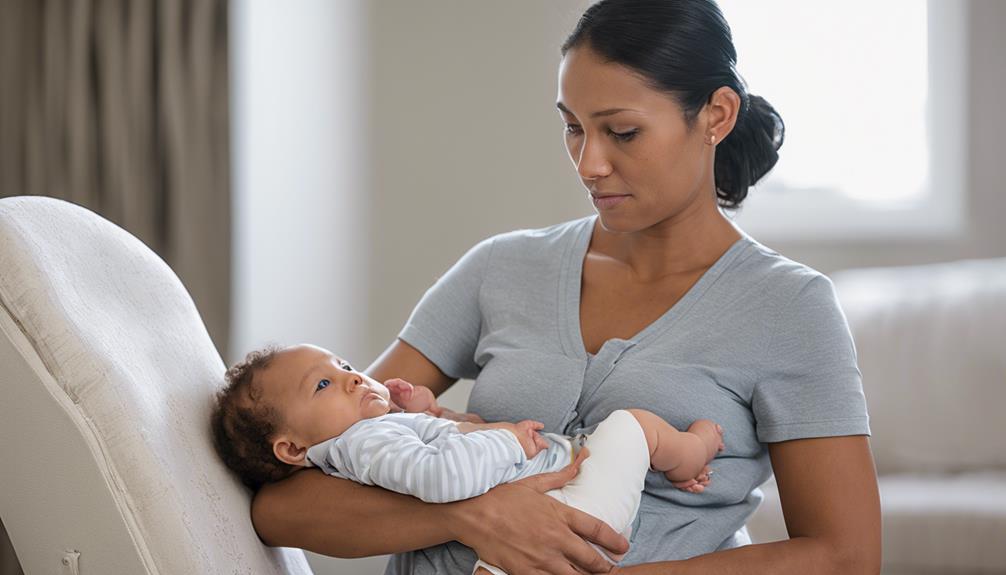To protect your baby’s delicate skin year-round, dress them in lightweight, UPF 50+ clothing like long sleeves, pants, and wide-brimmed hats. Seek shade during peak sunlight hours and consider umbrellas or tents outdoors. Apply baby-safe sunscreen to exposed areas, and don’t forget that UV rays can penetrate clouds. Combining clothing, shade, and skin protection creates the best defenses—continue exploring to discover more tips for keeping your little one safe.
Key Takeaways
- Dress babies in lightweight, UPF 50+ protective clothing, including long sleeves, pants, and wide-brimmed hats, for all-year sun safety.
- Seek shade during peak hours (10 a.m. to 4 p.m.) and use umbrellas or tents to minimize direct UV exposure.
- Apply baby-safe, broad-spectrum sunscreen on exposed skin, reapplying frequently, especially after water or sweating.
- Choose clothing in darker colors and breathable fabrics to balance UV protection with comfort and prevent overheating.
- Remember that UV rays penetrate clouds, so consistent protection is essential even on cloudy days year-round.

Are you wondering how to protect your baby from the sun’s harmful rays? Ensuring your little one stays safe in the sun starts with understanding UV protection and making smart clothing choices. Babies have delicate, sensitive skin that burns more easily than adult skin, so taking proactive steps is essential. The first line of defense is choosing clothing that shields your baby from UV rays. Look for lightweight, tightly woven fabrics that provide maximum coverage without causing overheating. Long-sleeved shirts, full-length pants, and wide-brimmed hats are excellent options to cover your baby’s arms, legs, and face. Many brands now offer clothing specifically designed with UV protection, which adds an extra layer of defense. These garments often have a UPF (Ultraviolet Protection Factor) rating, indicating how effectively they block out harmful rays. When selecting clothing, prioritize those with UPF ratings of 50 or higher to ensure ideal protection.
Choose lightweight, UV-protective clothing with UPF 50+ to keep your baby safe and comfortable in the sun.
In addition to clothing, consider the color and material. Darker colors tend to absorb more UV rays, providing better protection than lighter shades. However, comfort is key, so choose breathable fabrics that won’t cause your baby to overheat. Remember, clothing choices should be practical and comfortable; if your baby is sweating or uncomfortable, they might resist wearing protective clothing altogether. Layering lightweight garments can help strike a balance between coverage and comfort, especially on particularly hot days.
Beyond clothing choices, UV protection involves more than just what your baby wears. Seek shade whenever possible, especially during peak sun hours between 10 a.m. and 4 p.m. This is when UV rays are at their strongest and pose the greatest risk. Use umbrellas or shade tents if you’re outdoors for extended periods. Even on cloudy days, UV rays can penetrate clouds, so protective clothing remains important regardless of the weather.
Applying a baby-safe, broad-spectrum sunscreen to exposed areas like the face, ears, and hands adds an extra layer of protection. Make sure the sunscreen is specifically formulated for infants, free from harmful chemicals, and tested for sensitive skin. Reapply frequently, especially if your baby is sweating or has been in the water.
Frequently Asked Questions
What Are the Best Clothing Materials to Protect Baby Skin?
When choosing clothing to protect your baby’s skin, opt for breathable textiles like cotton fabrics. These materials allow air to circulate, helping prevent overheating and irritation. Lightweight, tightly woven cotton keeps harmful UV rays at bay while ensuring comfort. Avoid synthetic fabrics, which can trap heat and moisture. By selecting breathable, natural textiles, you provide a comfy, protective layer that shields your little one from sun damage and keeps their skin healthy.
How Can I Tell if My Baby Is Overheating in the Sun?
When you’re out in the sun, keep a sharp eye on your baby, as they can easily show signs of overheating. Watch for baby heat signs like flushed cheeks, sweating, fussiness, or rapid breathing. If you notice these, it’s a clear sign of sun overexposure. To prevent trouble, take breaks in the shade, keep them hydrated, and remove excess clothing. Remember, better safe than sorry under the blazing sun.
Are There Natural Remedies to Soothe Sun-Exposed Baby Skin?
If your baby’s sun-exposed skin looks irritated, you can try natural remedies to soothe it. Herbal remedies like cooled chamomile or aloe vera gel often help calm redness and inflammation. Additionally, gentle, soothing lotions with natural ingredients can provide relief. Always guarantee these remedies are safe for babies and consult your pediatrician before applying. These natural options can help comfort your baby’s delicate skin after sun exposure.
How Often Should I Reapply Sunscreen on My Baby?
You should reapply sunscreen on your baby every two hours to guarantee consistent protection. If your baby is swimming or sweating, reapply sooner. Remember, sunscreen reapplication is crucial for maintaining baby skin protection, especially during prolonged sun exposure. Use a broad-spectrum, SPF 50 formula suited for delicate skin. Keep a close eye on your baby, and don’t forget to apply sunscreen generously on all exposed areas for maximum protection.
Can Uv-Protective Clothing Be Used Indoors?
You might wonder if UV clothing effectiveness extends indoors. Indoor UV protection isn’t necessary because UV rays are mostly blocked by windows, but UV-protective clothing can still offer extra defense if your baby is near windows or in sunlit areas. While UV clothing provides good indoor UV protection, it’s best used outdoors for maximum effectiveness. Keep an eye on sunlight exposure and use protective clothing accordingly.
Conclusion
Protecting your baby’s delicate skin isn’t just a summer concern; it’s a year-round priority. While the warmth of sunshine feels inviting, it also brings risks. By implementing consistent sun safety habits, you shield your little one from harm, even on cloudy days. Just as the seasons change, so should your precautions. Remember, safeguarding their skin now lays the foundation for healthy, happy futures—because sometimes, the gentle sun can be the most powerful threat.









